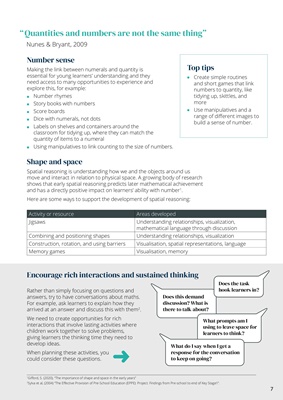
" Quantities and numbers are not the same thing"
Nunes & Bryant, 2009
Number sense
Making the link between numerals and quantity is
essential for young learners' understanding and they
need access to many opportunities to experience and
explore this, for example:
l Number rhymes
l Story books with numbers
l Score boards
l Dice with numerals, not dots
l Labels on shelves and containers around the
classroom for tidying up, where they can match the
quantity of items to a numeral
l Using manipulatives to link counting to the size of numbers.
Shape and space
Spatial reasoning is understanding how we and the objects around us
move and interact in relation to physical space. A growing body of research
shows that early spatial reasoning predicts later mathematical achievement
and has a directly positive impact on learners' ability with number1.
Here are some ways to support the development of spatial reasoning:
Top tips
l Create simple routines
and short games that link
numbers to quantity, like
tidying up, skittles, and
more
l Use manipulatives and a
range of different images to
build a sense of number.
Activity or resource Areas developed
Jigsaws Understanding relationships, visualization,
mathematical language through discussion
Combining and positioning shapes Understanding relationships, visualization
Construction, rotation, and using barriers Visualisation, spatial representations, language
Memory games Visualisation, memory
Rather than simply focusing on questions and
answers, try to have conversations about maths.
For example, ask learners to explain how they
arrived at an answer and discuss this with them2.
We need to create opportunities for rich
interactions that involve lasting activities where
children work together to solve problems,
giving learners the thinking time they need to
develop ideas.
When planning these activities, you
could consider these questions.
Encourage rich interactions and sustained thinking
Does the task
hook learners in?
Does this demand
discussion? What is
there to talk about?
What prompts am I
using to leave space for
learners to think?
What do I say when I get a
response for the conversation
to keep on going?
7
1Gifford, S. (2020), "The importance of shape and space in the early years"
2Sylva et al, (2004) "The Effective Provision of Pre-School Education (EPPE): Project: Findings from Pre-school to end of Key Stage1".